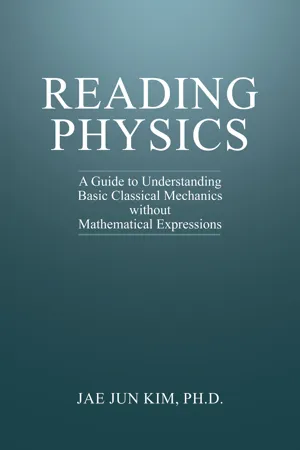Mathematics
Problems involving Relative Velocity
Problems involving Relative Velocity deal with the motion of objects in relation to each other. These problems require the use of vector addition and subtraction to determine the velocity of one object relative to another. The key is to understand the direction and magnitude of the velocities involved.
Written by Perlego with AI-assistance
Related key terms
3 Key excerpts on "Problems involving Relative Velocity"
- eBook - ePub
- A. D. Johnson(Author)
- 2017(Publication Date)
- CRC Press(Publisher)
On a motorway, car 1 travels at 50 km/h and is overtaken by car 2 travelling at 70 km/h. The relative velocity is the velocity car 2 appears to be travelling when observed from car 1.i.e. car 2 is travelling ‘relatively’ 20 km/h faster than car 1.relative velocity= velocity of car 2 − velocity of car 1= 70 − 50 = 20km/hFigure 2.9 shows car 1, again travelling at 50 km/h, in a positive direction. Car 3 is travelling at 60 km/h in the opposite direction (in a negative direction). The relative velocity is the velocity at which car 3 appears to be travelling when observed from car 1. The relative velocity in this case is the algebraic subtraction of the velocities of car 1 and car 3. This takes into account the negative direction of car 3, as shown below:relative velocity= velocity of car 1 − ( − velocity of car 3)= 50 − ( − 60) = 110km/h2.5.1 Absolute velocity
Hitherto, it has been assumed that all velocities have been absolute velocities, that is, all measurements and observations were made as if the observer were stationary on the earth’s surface while watching the moving body. This absolute velocity is a special case of relative velocity since the observations are made from the earth’s surface, which is considered to be a fixed reference point.2.5.2 Resultant of two velocities
Velocity possesses magnitude and direction and can, therefore, be represented in terms of a vector.Two velocities which act at right angles to each other can be represented by a single vector, indicating the combined direction and velocity. Early aircraft navigation relied on this method. Before navigational aids were used to plot the position of aircraft the early flyers plotted the air speed as a vector on a chart and estimated the effects of side winds on the aircraft. These were drawn on the chart as vectors. The resultant velocity showed the true speed and direction of the aircraft.Example 2.8An ocean linear steams 20 knots due north and is affected by 5 knot currents acting normal to the ship. (A knot is a nautical sea mile/h.) Determine the magnitude and. direction of the resultant velocity using: - eBook - ePub
- Kenneth W Ford(Author)
- 2016(Publication Date)
- WSPC(Publisher)
only for this example), the Pythagorean theorem for right triangles may be applied:With vp = 5 ft/sec and vt = 12 ft/sec, the magnitude of the total velocity is 13 ft/sec. This velocity makes an angle with the track whose sine is 5/13, approximately 23 deg. This kind of relative-motion problem is of practical importance to pilots. The velocity v of an airplane with respect to the ground is the vector sum of its velocity with respect to the air (vp ) and the velocity of the air, that is, the wind velocity (vw ):v = vp + vw .The rule for subtracting vectors is very simple: reverse the direction of the arrow representing the vector to be subtracted, then add. This is obviously similar to the rule for subtracting a number: Reverse its sign and add. Suppose that an observer on the ground measures a certain wind velocity vw and also measures the velocity v of a passing airplane with respect to the ground. He wants to know the velocity vp of the airplane with respect to the air. From the observed airplane velocity he must subtract the wind velocity,vp = v – vw .Such an example is illustrated diagrammatically in Figure 6.8 .FIGURE 6.8 An airplane moves with velocity v relative to the ground. The wind velocity is vw . The velocity vp of the airplane relative to the air is the difference v – vw .Any number of vectors may be successively added and subtracted graphically. The result of such a vector calculation is always represented by an arrow drawn from the starting point to the end point. An example of the addition of four vectors is shown in Figure 6.9 - eBook - ePub
Reading Physics
A Guide to Understanding Basic Classical Mechanics without Mathematical Expressions
- Jae J. Kim(Author)
- 2023(Publication Date)
- Universal Publishers(Publisher)
Remember: understanding the differences between vector and scalar is important. Likewise, it is also very important to understand what the orthogonality relationship is, especially when you are going to study a projectile motion, a motion in two- or higher dimensional space. If you do not understand what the relationship is about, you are going to have a hard time firmly grasping how we end up with various physical quantities in the projectile motions in higher dimensional space. For that reason, I highly encourage you to ensure that you understand what the orthogonality relationship is about, especially in the Cartesian coordinate system, before moving on to the topics in dynamics, including Newton’s laws of motion.Problems:Day 10 Motion in the vertical direction You hold a coin and then release it. What does the motion associated with the coin look like?Imagine you are driving a car going 80 miles per hour on a highway and a truck driver is driving his or her truck on the opposite side with the same magnitude of velocity. Think about the relative velocity of your car with respect to the truck and vice versa.For the example that is described in the lesson, imagine that someone else is moving with the same the velocity as that of the wind; calculate the velocity of your car with respect to that someone else.You are driving your car 40 miles per hour from south to north and the wind happens to blow from west to east at 30 miles per hour. Calculate the velocity of your car with respect to a person standing on the ground. Calculate the velocity of your car with respect to the wind. Think about the difference between the two cases.Find the two most common coordinate systems in physics. Define the two coordinate systems and think about the reason or reasons that it is easier to understand the orthogonality in Cartesian coordinates.You hold a coin and release it. What happens then? The increase in velocity is affected by the size of the gravitational acceleration. In essence, that is all that we need to know when studying a motion in the vertical direction.You hold an object and realize that it accelerates because of the Earth. That is what a motion in the vertical direction is about.
Index pages curate the most relevant extracts from our library of academic textbooks. They’ve been created using an in-house natural language model (NLM), each adding context and meaning to key research topics.


